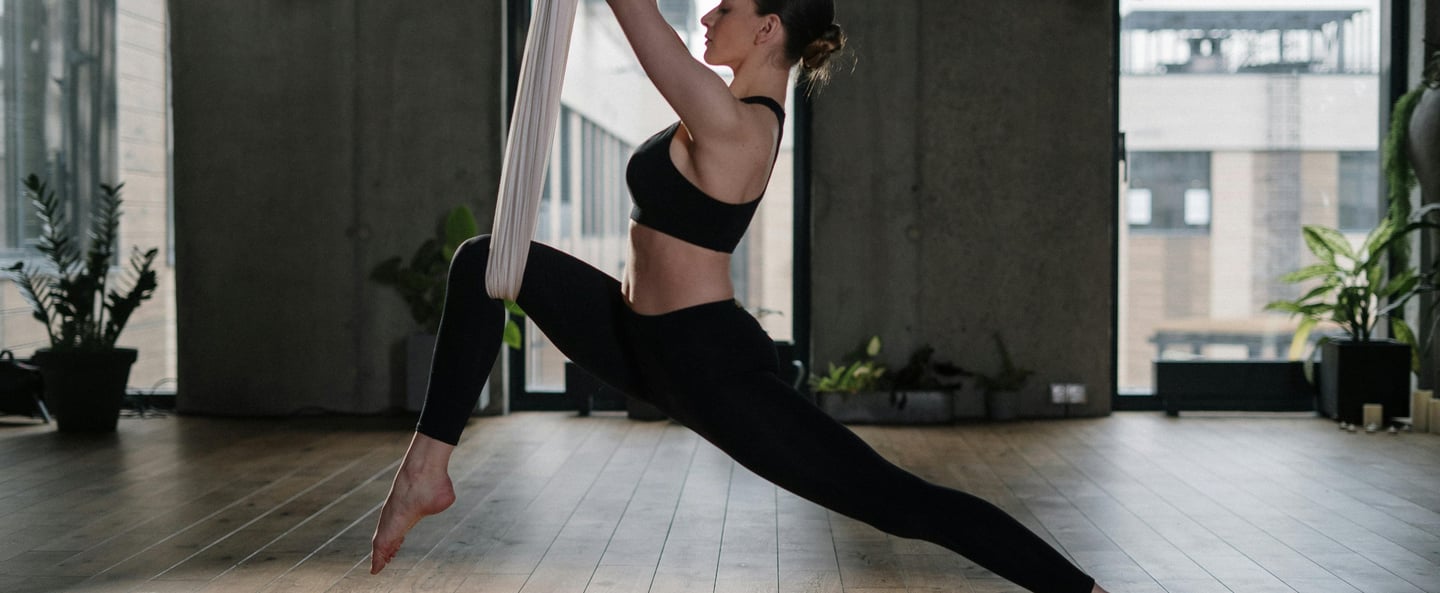AERIAL YOGA for Beginners
Aerial yoga is a unique style of yoga that uses a fabric hammock or silk (often referred to as an aerial sling or aerial hammock) to support the body while performing traditional yoga poses. The hammock is suspended from the ceiling, allowing practitioners to stretch, strengthen, and decompress in ways that are difficult to achieve on the mat alone. Aerial yoga classes combine elements of traditional yoga and Pilates, offering a creative and fun twist to the practice.
What to Expect in an Aerial Yoga Class
Warm-Up and Stretching:
Classes typically begin with a gentle warm-up to prepare the body. This might include basic stretches, deep breathing exercises, and light movements to engage muscles and increase flexibility.
The hammock is set up in such a way that it provides support for the body, allowing students to ease into deeper stretches or postures than they might on the mat.
Basic Poses and Alignment:
In the early stages of class, students learn how to safely interact with the hammock. This might include practicing poses like child's pose, seated forward bends, or cat-cow with the support of the sling.
Teachers emphasize proper alignment and how to use the hammock to help the body relax into poses, while also encouraging deeper stretching.
Strength-Building:
As the class progresses, more strength-building exercises are introduced. These can include using the hammock to perform planks, push-ups, or core work that targets the abdominals, shoulders, and arms.
Aerial yoga requires balancing on the hammock, which engages stabilizer muscles, helping improve overall body strength and coordination.
Inversions:
One of the standout features of aerial yoga is the opportunity to practice inversions (upside-down poses), which are often difficult or intimidating in traditional yoga. With the hammock providing support, students can safely experience inverted poses like downward dog, plow pose, or floating pigeon.
These inversions promote spinal decompression, increase circulation, and give the body a new perspective.
Cool-Down and Relaxation:
The class typically ends with a cool-down period, which may include restorative poses, gentle stretches, and a final relaxation in the hammock. Some classes use the hammock to support a gentle savasana, allowing the body to fully relax and restore after the practice.
Benefits of Aerial Yoga
Improved Flexibility:
The hammock allows for deeper stretches without putting as much strain on the muscles. The support of the fabric helps release tension, enabling students to ease into more flexible positions and increase their range of motion.
Increased Strength:
Aerial yoga engages the core, arms, and shoulders more intensively than traditional yoga. As you use the hammock for support or to challenge balance, you'll develop stronger muscles and improve your stability.
Spinal Decompression:
One of the unique benefits of aerial yoga is the ability to perform inversions or gentle stretches that decompress the spine. Inversions, like hanging upside down in the hammock, help alleviate pressure from the spine and can offer relief for people with back pain or tightness.
Better Posture:
By using the hammock to guide your alignment and support your body in poses, aerial yoga helps improve posture. The practice encourages awareness of body mechanics, alignment, and balance, which can translate to better posture in everyday life.
Stress Relief and Relaxation:
Aerial yoga offers a sense of playfulness and lightness, making it a great way to de-stress. The support of the hammock helps students relax deeply, and inversions can trigger the release of endorphins (the body’s natural mood elevators).
The floating feeling and focus on breath can help calm the nervous system, leading to a deep sense of relaxation and stress relief.
Boosted Circulation:
Inversions and the gentle movement of the hammock improve blood flow throughout the body. This enhanced circulation helps nourish tissues, improve energy levels, and increase overall vitality.
Mental Focus and Clarity:
Like traditional yoga, aerial yoga encourages mindfulness, balance, and body awareness. It requires focus and concentration as students move through poses with the hammock. This mental engagement can improve clarity and present-moment awareness.
Fun and Playful:
Aerial yoga offers a fun, unique twist on a traditional yoga practice. The use of the hammock adds an element of playfulness that can be particularly enjoyable for beginners or those who are looking to break free from traditional workout routines.
Who Can Benefit from Aerial Yoga?
Aerial yoga is suitable for people of all ages and fitness levels. It’s particularly beneficial for:
Beginners who may find traditional yoga difficult due to flexibility or strength challenges.
Experienced yoga practitioners who want to deepen their practice or add a new challenge.
People with back pain or those looking for spinal decompression.
Anyone looking for a fun, creative workout that combines strength, flexibility, and mindfulness.
However, individuals with certain conditions, such as high blood pressure, glaucoma, or heart issues, should consult with a healthcare professional before attempting aerial yoga due to the inversion element.
Conclusion
Aerial yoga is a refreshing and exciting approach to traditional yoga. It provides numerous physical and mental benefits, including enhanced flexibility, strength, and relaxation, while offering a sense of play and adventure. Whether you're new to yoga or an experienced practitioner, aerial yoga offers a fun and effective way to challenge your body and mind in a unique way!






